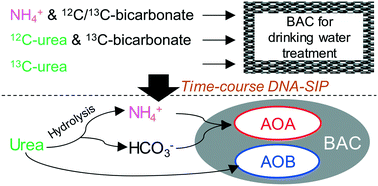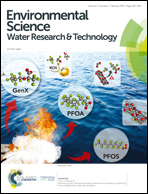Growth competition between ammonia-oxidizing archaea and bacteria for ammonium and urea in a biological activated carbon filter used for drinking water treatment
Abstract
Nitrification is a major ecological process occurring in biological activated carbon (BAC) filters used for advanced drinking water treatment. Ammonia oxidation is a rate-limiting step in nitrification that depends on the activity of ammonia-oxidizing archaea (AOA) and ammonia-oxidizing bacteria (AOB) associated with BAC. However, the growth competition between AOA and AOB remains unclear. In this study, time-course DNA-stable isotope probing (DNA-SIP) was applied to compare the growth activities of AOA and AOB for ammonium and urea in a BAC filter, in which AOA were more abundant than AOB. When a low level of ammonium (0.14 mg N L−1) was continuously supplied to BAC, AOA demonstrated higher autotrophic growth activity. A similar trend was noticed in a microcosm supplied with a low concentration of urea (0.14 mg N L−1) and 13C-labeled bicarbonate (H13CO3−). However, the microcosm supplied with only 13C-urea as the sole nitrogen and carbon source indicated faster assimilation of carbon derived from urea by AOB. It is likely that AOB could directly incorporate and hydrolyze urea for nitrification. On the other hand, AOA demonstrated growth activity only when bicarbonate was added to urea, suggesting that they did not directly incorporate urea for nitrification. Thus, the different substrate affinities of AOA and AOB to ammonium and urea seem to be the reason for the niche separation on BAC. Understanding the different responses of ammonia oxidizers to nitrogen substrates may contribute to the improvement of BAC design and operation in actual advanced drinking water treatment.



 Please wait while we load your content...
Please wait while we load your content...